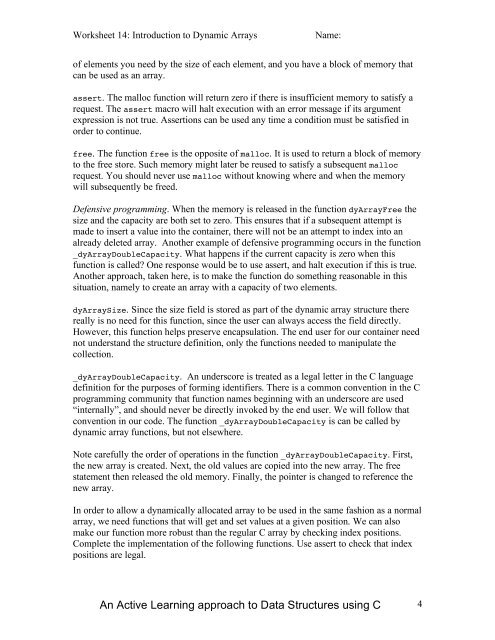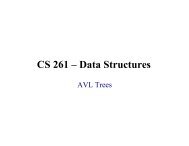Worksheet 14: Introduction to the Dynamic Array - Classes
Worksheet 14: Introduction to the Dynamic Array - Classes
Worksheet 14: Introduction to the Dynamic Array - Classes
You also want an ePaper? Increase the reach of your titles
YUMPU automatically turns print PDFs into web optimized ePapers that Google loves.
<strong>Worksheet</strong> <strong>14</strong>: <strong>Introduction</strong> <strong>to</strong> <strong>Dynamic</strong> <strong>Array</strong>s<br />
Name:<br />
of elements you need by <strong>the</strong> size of each element, and you have a block of memory that<br />
can be used as an array.<br />
assert. The malloc function will return zero if <strong>the</strong>re is insufficient memory <strong>to</strong> satisfy a<br />
request. The assert macro will halt execution with an error message if its argument<br />
expression is not true. Assertions can be used any time a condition must be satisfied in<br />
order <strong>to</strong> continue.<br />
free. The function free is <strong>the</strong> opposite of malloc. It is used <strong>to</strong> return a block of memory<br />
<strong>to</strong> <strong>the</strong> free s<strong>to</strong>re. Such memory might later be reused <strong>to</strong> satisfy a subsequent malloc<br />
request. You should never use malloc without knowing where and when <strong>the</strong> memory<br />
will subsequently be freed.<br />
Defensive programming. When <strong>the</strong> memory is released in <strong>the</strong> function dy<strong>Array</strong>Free <strong>the</strong><br />
size and <strong>the</strong> capacity are both set <strong>to</strong> zero. This ensures that if a subsequent attempt is<br />
made <strong>to</strong> insert a value in<strong>to</strong> <strong>the</strong> container, <strong>the</strong>re will not be an attempt <strong>to</strong> index in<strong>to</strong> an<br />
already deleted array. Ano<strong>the</strong>r example of defensive programming occurs in <strong>the</strong> function<br />
_dy<strong>Array</strong>DoubleCapacity. What happens if <strong>the</strong> current capacity is zero when this<br />
function is called? One response would be <strong>to</strong> use assert, and halt execution if this is true.<br />
Ano<strong>the</strong>r approach, taken here, is <strong>to</strong> make <strong>the</strong> function do something reasonable in this<br />
situation, namely <strong>to</strong> create an array with a capacity of two elements.<br />
dy<strong>Array</strong>Size. Since <strong>the</strong> size field is s<strong>to</strong>red as part of <strong>the</strong> dynamic array structure <strong>the</strong>re<br />
really is no need for this function, since <strong>the</strong> user can always access <strong>the</strong> field directly.<br />
However, this function helps preserve encapsulation. The end user for our container need<br />
not understand <strong>the</strong> structure definition, only <strong>the</strong> functions needed <strong>to</strong> manipulate <strong>the</strong><br />
collection.<br />
_dy<strong>Array</strong>DoubleCapacity. An underscore is treated as a legal letter in <strong>the</strong> C language<br />
definition for <strong>the</strong> purposes of forming identifiers. There is a common convention in <strong>the</strong> C<br />
programming community that function names beginning with an underscore are used<br />
“internally”, and should never be directly invoked by <strong>the</strong> end user. We will follow that<br />
convention in our code. The function _dy<strong>Array</strong>DoubleCapacity is can be called by<br />
dynamic array functions, but not elsewhere.<br />
Note carefully <strong>the</strong> order of operations in <strong>the</strong> function _dy<strong>Array</strong>DoubleCapacity. First,<br />
<strong>the</strong> new array is created. Next, <strong>the</strong> old values are copied in<strong>to</strong> <strong>the</strong> new array. The free<br />
statement <strong>the</strong>n released <strong>the</strong> old memory. Finally, <strong>the</strong> pointer is changed <strong>to</strong> reference <strong>the</strong><br />
new array.<br />
In order <strong>to</strong> allow a dynamically allocated array <strong>to</strong> be used in <strong>the</strong> same fashion as a normal<br />
array, we need functions that will get and set values at a given position. We can also<br />
make our function more robust than <strong>the</strong> regular C array by checking index positions.<br />
Complete <strong>the</strong> implementation of <strong>the</strong> following functions. Use assert <strong>to</strong> check that index<br />
positions are legal.<br />
An Active Learning approach <strong>to</strong> Data Structures using C 4

















